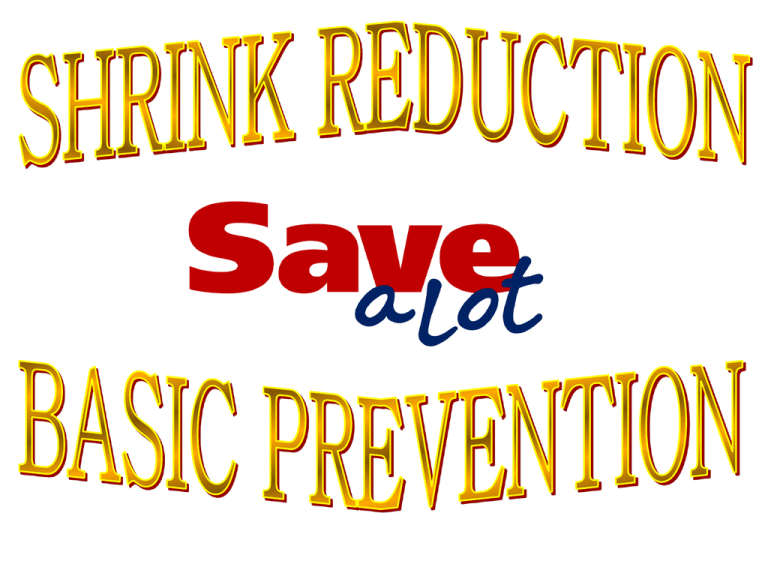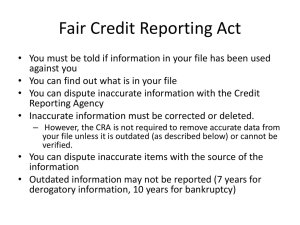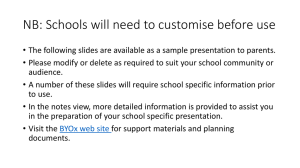Shrink Training PowerPoint
advertisement

DISCIPLINE • Training that corrects, molds, and perfects! • Control gained by enforcing order. • To train or develop by instruction and exercise in self-control. FOCUS • The center of activity or attention! • Concentrate • Attention on the most urgent problems Shrink Control Attitude • Each Store Manager must develop a shrink control ATTITUDE! SHRINK ATTITUDE Receiving Product Do you understand and enforce correct check-in procedures for all deliveries? Are your stockroom, coolers, and freezers prepared to receive product? Are Vendors permitted to wander throughout the store and be left unattended away from their authorized area? Receiving Product Who is responsible to ensure that all invoices are processed properly? Do you have established times for deliveries? How can you better monitor receiving procedures in your store? Who is authorized to check in vendors? Are Invoices reviewed for correct cost and retail extensions? Handling Product Do you understand and enforce correct handling procedures? How much time have you spent in properly training your employees to stock? How do you account for the instore use of product? How is perishable product handled at your store? Are there any opened product or packaging found laying around in the breakroom, bathrooms, backroom, office, in the trash or in/on top of coolers and freezers without proof of purchase? Is a policy for employee purchases in place? HANDLING PRODUCTS STOCKING PRODUCTS Handling Product What is your procedure for maintaining proper temperature control for perishable products? How do you verify proper rotation of product? How do you insure there is no razor cut product in your store? How are damaged, reduced, or spoiled products handled and accounted for? What method do you use for proper storage and rotation in your stockroom, freezers and coolers? How can you improve your shrink loss in handling product? PERISHABLE HANDLING PRODUCT ROTATION BREAKROOM ACTIVITY Front End What causes shrink losses due to relaxed Front End operations? What is covered in training employees to operate a cash register in your store? How do you handle file maintenance, price errors, and “Not on File” items in your store? How do you monitor cash register transactions? How does inaccurate pricing adversely effect your store? How are voids, refunds, and coupons monitored? How often and who conducts till audits and customer bag checks in your store? Front End Is your store on a retail bill out system to identify what your inventory loss is? How are relatives and friends of employees checked out? When and who may make price or department changes in your registers? Store Security Do you understand what total store security really means? Who has the keys to your store, office, backdoor, cash register, journal tapes, and vending machines? Who watches the front doors to insure the proper entry and exit of customers and employees? Are locks, security codes and safe combinations changed whenever a key employee leaves the company? Are all doors and windows kept closed and locked when not attended by an authorized employee? HI’S, EYES, AND HELP! • HI’S All employees say hi and smile at customers. The customer knows you saw them and may think you know them. • EYES Make eye contact. Have a watchful mindset. Be aware of what is going on in your store. Watch suspicious customers. • HELP Be visible, approach customer and say “Can you find everything you need? “ If not, take them to the item. (Get those extra sales). HI’S, EYES, AND HELP! • Use Hi’s, Eyes, and Help as a deterrent to customer theft in your store. At the same time, improve your customer courtesy level and your sales. Demonstrate your customer courtesy standards consistently. We all do this, but we can all improve! Store Security What is your employee purchase policy? Who has access to your store’s alarm codes? What steps do you take to prevent shoplifting ? What steps are taken to prevent employee theft? How do you identify and monitor the top five high theft items in your store? Is the store ever left unattended without a qualified management person? Store Security What is the procedure for the inspection and disposal of trash? What steps are taken to screen new employees prior to hiring? Does the store manager periodically assist in the calculation of the meat and produce inventories? Are check lanes blocked off when registers are not in use? Are 2 people always on duty? Does anyone close the store alone? CHECKLANE SECURITY BACK ROOM SECURITY Attitudes Are Contagious! • If the manager has a shrink control attitude the other associates will develop a shrink control attitude! SHRINK……….. • ANY ACTION OR LACK OF ACTION THAT DECREASES THE VALUE OF A PRODUCT! • • • • • • • • • CAUSES OF SHRINK THEFT Internal Shoplifting Vendor DSD Pricing Damage Code Dates Overstocked Backroom CAUSES OF SHRINK • Grazing • Over merchandising (cutting, trimming, etc.) • Poor Refrigeration • Counter and case shrink • Late reaction • Poor Rotation • Poor Training • Poor Record Keeping Shrink Reduction Action What does it take to replace the cost of the product when lost, damaged, stolen or un-accounted for? Product Country Farms Yogurt Holley Hill Grade A Eggs Butterball Bologna Dentyne Ice 3 pack Gum 6 Pack Snickers 1 LB Ground Beef 1 Gal. Milk Total Qty Price Total 1 1 1 1 1 1 1 7 0.39 0.85 1.29 1.69 2.29 2.39 3.14 12.04 0.39 0.85 1.29 1.69 2.29 2.39 3.14 12.04 REPLACEMENT SALES (w/ 1% Avg. Profit) $ 39.00 $ 85.00 $129.00 $169.00 $229.00 $239.00 $314.00 $1,204.00 REACTION TO PRODUCT GRAZING ROTATION DAMAGED PRODUCTS Employee Theft “THE SILENT KILLER” • The object of this presentation is to help our retailers recognize and react to a problem that exists in every retail grocery store. EMPLOYEE THEFT • Employee theft is one of most serious threats to the success of a Save-A-Lot food store. It alone can be the difference between a profitable or non-profitable operation. Save-A-Lot operators and their management must learn to deal effectively with this area of shrink, not only to prevent loss from dishonest employees, but to realize the full potential of security procedures throughout their prospective operations. Employee Theft “THE SILENT KILLER” • Few employers or employees readily accept the possibility that the most significant factor in their total shrink figure is indeed employee theft. Most grocery retailers seem inclined to ignore this facet of their operation. This is not indicative of a lack of management skill, but rather human nature. Managers, as well as owners,often fall victim to an unfortunate paradox- -- “THE SILENT KILLER” • EMPLOYEES WHO HAVE SIGNIFICANTLY CONTRIBUTED TO THE SUCCESS OF THE STORE ARE NOT STEALING FROM THE STORE. Long standing friendships can become obstacles when considering employee theft as the root of low gross, high shrink, and eventually a failing business. Employee Theft “THE SILENT KILLER” • Hiring honest people and helping those people stay honest is the simplest way of summarizing the most productive approach in controlling employee theft. Of course all employees are neither honest or dishonest, but if proper policies and procedures are in place we can help to preserve a healthy work environment as well as secure a successful store operation. T.C.B. • “AN OUNCE OF PROTECTION IS WORTH A POUND OF CURE”, is a wise old saying that really applies to eliminating employee theft. IF means, method, and opportunity are controlled, it is likely that employee theft will be also. Lets review some alarming facts taken from recent industry surveys and important areas where control must be established and maintained, and how that can be accomplished. Components of Shrink Pricing 4% 3% 22% 5% Accounting Errors Damages 20% Shoplifting Receiving 35% 11% Cashier Caused General Employees Shrink Reduction Action POPULAR THEFT TYPES 40 30 26.7% 23.7% 20 15.6% 9.7% 10 6.7% 5.7% 5.6% 3.3% 2.9% as h C er ch an di se M in g isc ou nt D Sl id in g ng Sn ac ki er O th s ef un d oi ds /R or V ac kd o B C ou po n 0 Shrink Reduction Action THEFT TRIANGLE ABILITY DESIRE OPPORTUNITY 19% of us has the ABILITY to steal, 36% of us has the DESIRE to steal, and 45% of us will steal if given the OPPORTUNITY to do so. Make theft DIFFICULT, RISKY, and UNREWARDING for Shoplifters, Dishonest Employees, and Dishonest Vendors! Ways to reduce Employee Dishonesty • Minimize Opportunity • Reduce High Risk Employee Hiring • Create The Right Atmosphere • Train Employees To Be Aware Why Do People Steal? • Excuses such as,Bills to pay • Grudges against Employer • Drug or Alcohol Addiction • Justified by others stealing Is Management Aware Of Employee Theft Traits? • Certain Customers waiting for certain cashiers to open • Cashiers always checking to the penny • Notes at the register with numbers CASHIER THEFT • Notes at the register with numbers • Misplaced change in the drawer. ( Sign of cashier keeping up with under rings. Penny=$1.00, Nickel=$5.00, etc. This money would be taken out during down time prior to final countdown and pocketed.) • Always requesting to run the register farthest from the office • Personal phones calls Is Management Aware Of Employee Theft Traits? • Constant eye contact with management • Excessive voids,refunds,or no sales • Cashiers asking which management person is on duty THEFT TRAITS • Excessive break time • Over friendliness • Excessive time “working stock” in backroom or coolers • Unnatural or changes in usual behavior • Offering to “cover” for you while you take a break outside. Security Cash Handling - You are trusted to handle a large volume of cash transactions. You are responsible for accurate cash handling. Register Security - At no time may any employee open another employee’s register without the employee assigned to that register being present. Management may open an employee’s register only in an emergency. At no time may more than one employee use the same till to ring up customer orders. Employee Purchases - Do not ring up your own purchases. Management or designated personnel will check out your purchases. Product purchased for consumption must have a receipt, initialed by management, attached to the product. All other product must leave the store after the purchase is made. Lane Security - Whenever you leave the register be certain that you close off the lane with a cart or stack basket. Under-ringing- Sliding or discounting by charging less than retail price will be grounds for disciplinary action. Verifying Truck Loads • Verify the total load (All Pallets) • Work from pallet to invoice, looking for all types of discrepancies. • The number on the invoice should be matched up with the corresponding number on the pallet label. You are now ready to check the load. Keep in mind that the first item on the invoice may be at the bottom of the pallet. • Read the manufacturer’s product description on the case. • If items are found on the pallet but do not show on the invoice, check the shipping label. Place a check mark next to the item quantity on the invoice as you take the product off the pallet to stock. If multiple quantities are invoiced, but you find fewer, place the number found by the quantity on the invoice. • Product description. This could be a mis-pick. Write the item in on the invoice, then show the item invoiced as short and the mis-picked item as over. • After any mis-picks are identified, check the invoice for shortages. Identify the short items. Check the sales area for the shorted item in the event it was stocked without being noted on the invoice. Verifying Truck Loads • If the item does not show up on the sales area, check the stock room for the missing product. Shippers are often overlooked or misplaced. • Store Manager or Assistant Manager should verify any items not found on the invoice. If the item is still unaccounted for, check the invoice for the item number before and after the missing item to see if you are over on one of these items. • After completing all the steps above, fill out the Store Credit/Charge Log and fax to the warehouse. Don’t Leave The Door Open To Theft LET’S THINK OUTSIDE THE BOX • What are other potential shrink factors: –Workman’s Comp claims –Customer accidents –No signage or tagging on products –Improper stocking procedures WORKMAN’S COMP CUSTOMER ACCIDENTS SIGNAGE IMPROPER STOCKING Shrink Control= Road To A Successful Operation









